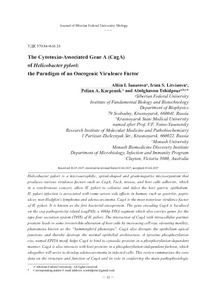Показать сокращенную информацию
The Cytotoxin-Associated Gene A (CagA) of Helicobacter pylori: the Paradigm of an Oncogenic Virulence Factor
| Автор | Tohidpour, Abolghasem | |
| Автор | Alfiia I. Iunusova | |
| Автор | Irina S. Litvinova | |
| Автор | Polina A. Karpenok | |
| Дата внесения | 2018-02-07T07:28:19Z | |
| Дата, когда ресурс стал доступен | 2018-02-07T07:28:19Z | |
| Дата публикации | 2017-04 | |
| Библиографическое описание | Tohidpour, Abolghasem. The Cytotoxin-Associated Gene A (CagA) of Helicobacter pylori: the Paradigm of an Oncogenic Virulence Factor [Текст] / Abolghasem Tohidpour, Alfiia I. Iunusova, Irina S. Litvinova, Polina A. Karpenok // SibFu Journal of Biology. — 2017. — С. 11-22 | |
| URI (для ссылок/цитирований) | https://elib.sfu-kras.ru/handle/2311/32143 | |
| URI (для ссылок/цитирований) | https://elib.sfu-kras.ru/handle/2311/69786 | |
| Аннотация | Helicobacter pylori is a microaerophilic, spiral-shaped and gram-negative microorganism that produces various virulence factors such as CagA, VacA, urease, and host cells adhesins, which in a synchronous concert, allow H. pylori to colonize and infect the host gastric epithelium. H. pylori infection is associated with some severe side effects in human, such as gastritis, peptic ulcer, non-Hodgkin’s lymphoma and adenocarcinoma. CagA is the most notorious virulence factor of H. pylori. It is known as the first bacterial oncoprotein. The gene encoding CagA is localized on the cag pathogenicity island (cagPAI), a 40kbp DNA segment which also carries genes for the type four secretion system (T4SS) of H. pylori. The interaction of CagA with intracellular partner proteins leads to some irreversible alteration of host cells by increasing cell size, elevating motility, phenomena known as the “hummingbird phenotype”. CagA also disrupts the epithelium apical junctions and thereby destroys the normal epithelial architecture. A tyrosine phosphorylation site, named EPIYA motif, helps CagA to bind to cytosolic proteins in a phosphorylation-dependent manner. CagA is also interacts with host proteins in a phosphorylation-independent fashion, which altogether will assist to develop adenocarcinoma in infected cells. This review summarizes the core data on the structure and function of CagA and its role in conferring the main pathophysiologic effects of H. pylori infection as well as suggesting a therapeutic option for treatment of H. pylori infection based on CagA virulence. | |
| Тема | adenocarcinoma | |
| Тема | cagPAI | |
| Тема | EPIYA | |
| Тема | T4SS | |
| Тема | hummingbird phenotype | |
| Название | The Cytotoxin-Associated Gene A (CagA) of Helicobacter pylori: the Paradigm of an Oncogenic Virulence Factor | |
| Тип | Journal Article | |
| Тип | Journal Article Preprint | |
| Страницы | 11-22 | |
| ГРНТИ | 34.17 | |
| Дата обновления | 2018-02-07T07:28:19Z | |
| DOI | 10.17516/1997-1389-0015 | |
| Институт | Институт фундаментальной биологии и биотехнологии | |
| Подразделение | Кафедра биофизики | |
| Журнал | SibFu Journal of Biology |

